This is an Ontoflex Modele B, a Twin Lens Reflex camera made by G. Cornu in Paris, France starting in 1934 to around 1940. The Ontoflex has an all metal body and shoots 6cm x 9cm images on Kodak’s 620 roll film, via a rotating film back which allowed it to make images in both portrait and landscape orientation. There are three distinct variations of the Ontoflex, this one being the third variation, each of which all have subtle differences and a wide range of available shutter and lens combinations. This particular example was a higher spec’d model, featuring a Compur-Rapid leaf shutter and a Carl Zeiss Jena Tessar taking lens. Only the viewfinder lens is French. The Ontoflex is a strange looking and very unique camera, but would be the company’s only TLR as its primary focus was on compact 35mm cameras.
Film Type: 620 Roll Film (eight 6cm x 9cm exposures per roll), Portrait or Landscape Orientation, Interchangeable Sheet Film Back
Lens (Taking): 10.5cm f/3.5 Carl Zeiss Jena Tessar uncoated 4-elements in 3-groups
Lens (Viewing): 105mm f/3.5 Reflex Ontor Paris uncoated unknown elements
Focus: 1.5 meters to Infinity
Viewfinder: Coupled Reflex Waist Level Finder w/ Sports Finder
Shutter: Compur-Rapid Leaf
Speeds: T, B, 1 – 1/400 seconds
Exposure Meter: None
Battery: None
Flash Mount: None
Weight: 1410 grams
Manual: https://www.cameramanuals.org/pdf_files/ontoflex_6x9.pdf
Pamphlet: https://www.pacificrimcamera.com/rl/04028/04028.pdf
The Ontoflex was produced by a French company called G. Cornu between the years 1934 and 1940. Very little information exists online about the Ontoflex series or the company that made it. In February 2024, Dan Cuny did a review of the Ontoflex and came to the realization that there was very little information about it online.
I attempted to utilize my years of experience in researching cameras, and I struggled to find much more than what you can easily find on the Ontoflex’s camera-wiki page.
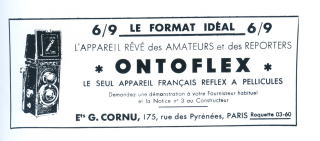
As best as I can tell, Cornu is named after Georges Cornu. In my research, I discovered several French patents for cameras that look startlingly like the Ontoflex, but those were credited to Gustave Norbert Cornu. Is the “G” in G. Cornu for Georges or Gustave? If anyone reading this knows, please let me know in the comments.
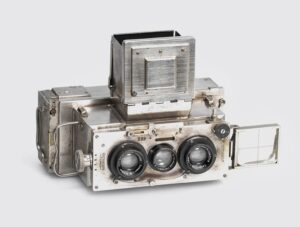
Cornu primarily built stereo cameras called the Ontoscope between 1914 and 1933 but in 1934 released a new twin lens reflex called the Ontoflex. The Ontoflex likely appealed to those interested in the German Rolleiflex and Rolleicord models made by Franke & Heidecke. For those in France, restrictive trade practices meant that importing a German camera was expensive, so the Ontoflex would have been a cost effective option.
Despite having the same form factor as the Rolleiflex, the Ontoflex was a very different camera. Instead of shooting square 6×6 images, it shot larger 6×9 images, but added the flexibility of a rotating film back in whcih you could expose images in a landscape or portrait orientation, without having to rotate the entire camera. In addition, some models had a removable film back for use with Ontoflex specific sheet film holders.
Collectors today distinguish Cornu Ontoflexes between Model A versions with a non-removable back and Model Bs with a removable back. The one I’m reviewing here has a removable back, making it a Model B, but beyond that, from what I can see, it is difficult to make a generalization between different cameras as the changes vary wildly.
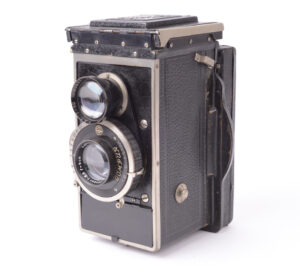
According to collection-appareils.fr, there are three series of Ontoflexes, the 6000, 7000, and 8000 series which are indicated by the camera’s serial numbers. The site attempts to discern the differences between cameras made in each of the three series referring them as No.1, No.2, and No.3 models, and while there are several significant differences between the different series of Ontoflexes, I don’t know that its correct to clearly group the cameras into three distinct buckets as it was clear this camera was ever evolving, with minor changes being made throughout its entire run. In addition, serial numbers in the 9xxx and 10xxx range exiust too, further confusing matters. One final complexity is that there were many different combinations of lenses and shutters available, some of which are common between cameras in all three buckets.
Where is the serial number? At first, I struggled to find my camera’s serial number as it was not in any of the usual locations you’d expect to find serial numbers, until I noticed it staring at me in the face, on the side of the lens standard, in between the viewing and taking lens. My example is number 9249.
Based on a very unscientific approach of looking at photos of as many Ontoflexes as I could find in which the serial number is readable, I can conclude the following:
-
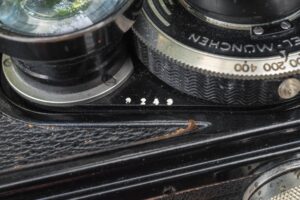
The Ontoflex serial number is located on the front plate between the two lenses. Models with 6xxx and 7xxx serial numbers are the least common. I am unsure of production numbers, but they clearly do not extend from 6000-6999 or 7000-7999. Most likely only a couple hundred of each series were made. These models are easy to identify as they have a compartment on the front of the camera below the taking lens for storing an extra roll of film. Side by side, these cameras have a different shaped body and film compartment compared to later models.
- Models with 8xxx, 9xxx, and 10xxxx models lack the door for the spare roll of film and have a totally different front and an ONTOFLEX name plate above the viewfinder lens. These are the most common models to find, with production probably in the several thousands.
- Models with 10xxx serial numbers lose the leather body covering, instead having a crackle paint finish. It is thought that these were discounted models built to be sold at a more affordable price near the end of the camera’s production.
- There is no correlation between those with non-removable (Model A) and removable (Model B) backs, as both appear in all serial number ranges.
- Models with support for 6×4.5 images have been found in the 10xxx range, suggesting this was a planned feature, or perhaps was a common modification to these cameras.
- Some assorted models have been found with chrome finishes, larger than normal film advance knobs, aluminum focus knobs, body mounted flash sync ports, and a few other cosmetic differences.
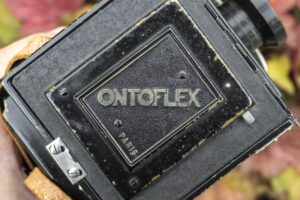
The Ontoflex is a camera that is rarely seen, even by seasoned collectors. The only estimate I’ve found of how many were made suggests that around 10,000 were made, but this number seems high to me. If there were 10,000 made, perhaps many never made it out of France, or were possibly returned to the factory at one point and destroyed because they are very hard to find. As I write this, a search of International eBay returns only one for sale from a seller in Poland with what I consider to be a ridiculous asking price of $1500 USD.
When I had a chance to review this camera, I understandably jumped at it. The first thing I observed with the camera was its large size. This thing towers over a “normal” Twin Lens Reflex. Without knowing anything about the camera, you might guess that it makes larger than 6×6 images, and you’d be right. Another hint at a larger than usual exposure size is the 10.5cm focal length of the lenses. If this were a Rolleiflex, lenses like that would be considered medium telephoto.
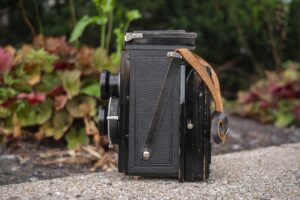
The Ontoflex’s build quality is on par with other German cameras of the same era. I question the manner in which the rotating film back attaches to the camera as I don’t have a lot of confidence in its ability to prevent light leaks, but apparently it is good enough. Compared to the Welta Superfekta, which is the only other 6×9 TLR I’ve ever seen with a swiveling back, the solid body design of the Ontoflex suggests it should handle more use without risk of bending the folding struts or damaging the exposed bellows of the Welta.
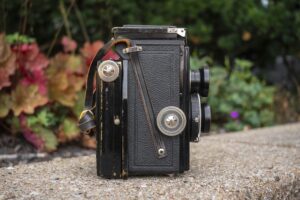
Functionally, this example was in perfect working order and that it has a regular Compur Rapid shutter means that had it needed some shutter service, this would be an easy camera to work on. Certainly less difficult than other 1930s TLRs like the Rolleiflex Standard or Voigtländer Superb. The only functional issue on this example was a haze that had formed over the silvered surface of the reflex mirror, making the view through the waist level finder than it would have been with a brand new mirror.
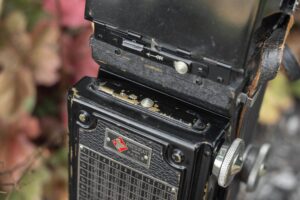
For being such a unique camera, the operation of the Ontoflex is pretty simple. The Compur Rapid shutter has controls for shutter speed and aperture in the usual locations, as are the shutter cocking lever and shutter release. Like other Compur Rapids of the same era, there is a self timer which is activated using a round switch near the end of the travel for the cocking lever. Due to the arrangement of the shutter and viewfinder lens, the shutter is installed at a 90 degree angle, with the “top” of the shutter facing the camera’s right side. Ontoflexes can be found with a large variety of shutters, so if you find one without a Compur-Rapid, I suspect those shutters would be consistent in operation.
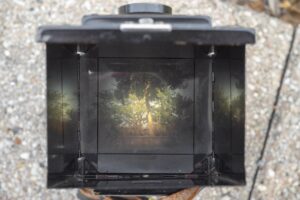
The viewfinder is not as complicated as the one in the Welta Superfekta which has moving masks that change position depending on if the camera is in landscape or portrait orientation. In the Ontoflex, a square finder has two sets of frame lines, one horizontal and one vertical which you are supposed to frame your image in depending on how the film back is set. There is nothing that couples the position of the back to the viewfinder, you just have to know which one to use. Inside the hood is a hinged magnifying glass which can be moved into position for precision focus, If a reflex finder is not for you, the Ontoflex has a sports finder, in which you can fold down the front face of the lid and peer through a square hole in the hood to approximate what will be captured on film. Since this is a square image, you have no way of framing a landscape or portrait image.
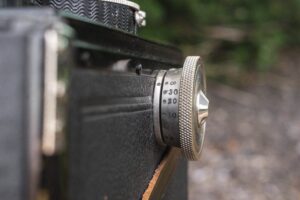
Focus and film advance are accomplished by simple knobs that work exactly as you’d expect them to. The film compartment swivels and works similarly to how a roll film back might work on a Graflex press camera. The film advance knob is on the right with it in portrait orientation, but moves to the bottom when in landscape orientation. There is no way to swivel the so the film advance knob is facing up.
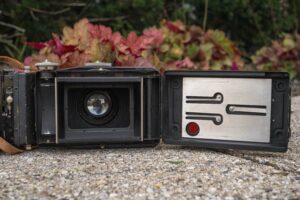
Loading film into the camera is uneventful, and is done the same way you’d do it on most roll film cameras. Despite this being a rare and unusual camera, it is well suited for novices or those who have never used a TLR before as there are no surprises in the usability of this camera.
Satisfied the Ontoflex was in good shape, I decided to be brave and load in a roll of semi-expired Fuji Acros 400 and take the camera out on a sunny day. With a top 1/400 shutter speed, I felt confident I should be able to get a whole roll of properly exposed images.
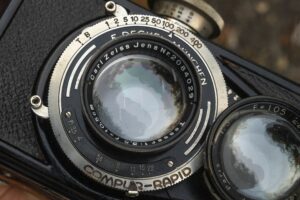
The Cornu Ontoflex might be an unfamiliar camera to most, but the Carl Zeiss Jena Tessar is not. This being a prewar lens, it is not coated, but that should have little impact on high contrast black and white images like those seen above. As you might expect, sharpness is excellent across the frame. A tiny amount of vignetting is visible in the extreme corners, but I don’t think that’s a result of the lens, rather than some type of internal baffling in the camera because it comes on too strong, too suddenly. The sharpness and detail across the large 90 centimeter width of the image is breathtaking. At least as good as any other quality 6×9 camera like the Kodak Medalist or the Fujica GL690 series. Looking at these images full size on a 32 inch computer monitor, the images look as good as any shot on a modern digital mirrorless with detail to spare.
I didn’t run into any problems other than leaving an exposure blank while out shooting as I couldn’t remember if I had advanced it or not. Whenever I run into that scenario, I always prefer to double advance and waste an exposure, rather than double expose two images together, ruining both. With a little more effort, Cornu could have added double exposure prevention to this camera, preventing this from happening to me, but I guess in 1930s France when this camera was being created, no one thought it was a priority.
If I had a wishlist for the camera, I found it a bit odd that this camera uses 620 film. Not that I have anything against 620 as its easy enough to respool 120 film onto 620 spools, but considering Kodak had just released the format in 1933, that an obscure French camera maker was already supporting it the very next year is curious. While other European camera makers also adopted 620, many of them supported dual format, using shafts that can accept 120 also, which the Ontoflex cannot do.
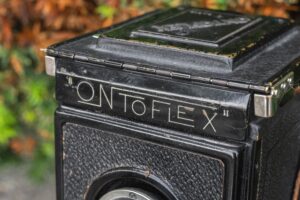
Before using the Ontoflex, I could see this was a relatively simple camera and after shooting a roll through it, my opinion has not changed. In fact, had it not been the excellent results from the Zeiss Tessar lens, I could see how this camera could be considered an economical choice with a lesser lens. All cameras are just light tight boxes for holding film, and there is little about the Ontoflex to change that generalization.

Confirming my suspicion, after seeing my results, I re-read Dan Cuny’s review of his Ontoflex Model A with a 90mm f3.5 H. Roussel Paris Ortho Kynor lens, and his images are noticeably softer and show less contrast than the ones produced by the Tessar. This isn’t to say Dan’s images aren’t nice, but that the range of what this camera is capable of varies greatly depending on how it was configured.
I quite enjoyed the experience of shooting the Cornu Ontoflex. With only two TLRs that I’ve ever come across which can shoot both 6×9 images in portrait and landscape orientation, there is an undeniable cool factor with this camera. That it has a reliable Compur shutter means that the camera shouldn’t be difficult to fix and its simple operation means you don’t need to spend a lot of time RTFM before shooting it. Although the Welta Superfekta is a more technically impressive camera, it is a lot more fragile, and for that reason, I feel much more comfortable throwing this (very large) camera into my camera bag for future rolls of film.
Related Posts You Might Enjoy
External Links
http://camera-wiki.org/wiki/Ontoflex
https://www.dancuny.com/camera-collecting-blog/2024/2/11/cornu-ontoflex
https://www.collection-appareils.fr/Timeline/frise.php?Marque=Cornu (This site has 14 different pages for the Ontoflex)
https://www.oldlens.com/ontoflex.html (in Japanese)
https://www.mobile01.com/topicdetail.php?f=255&t=2028534 (in Chinese)

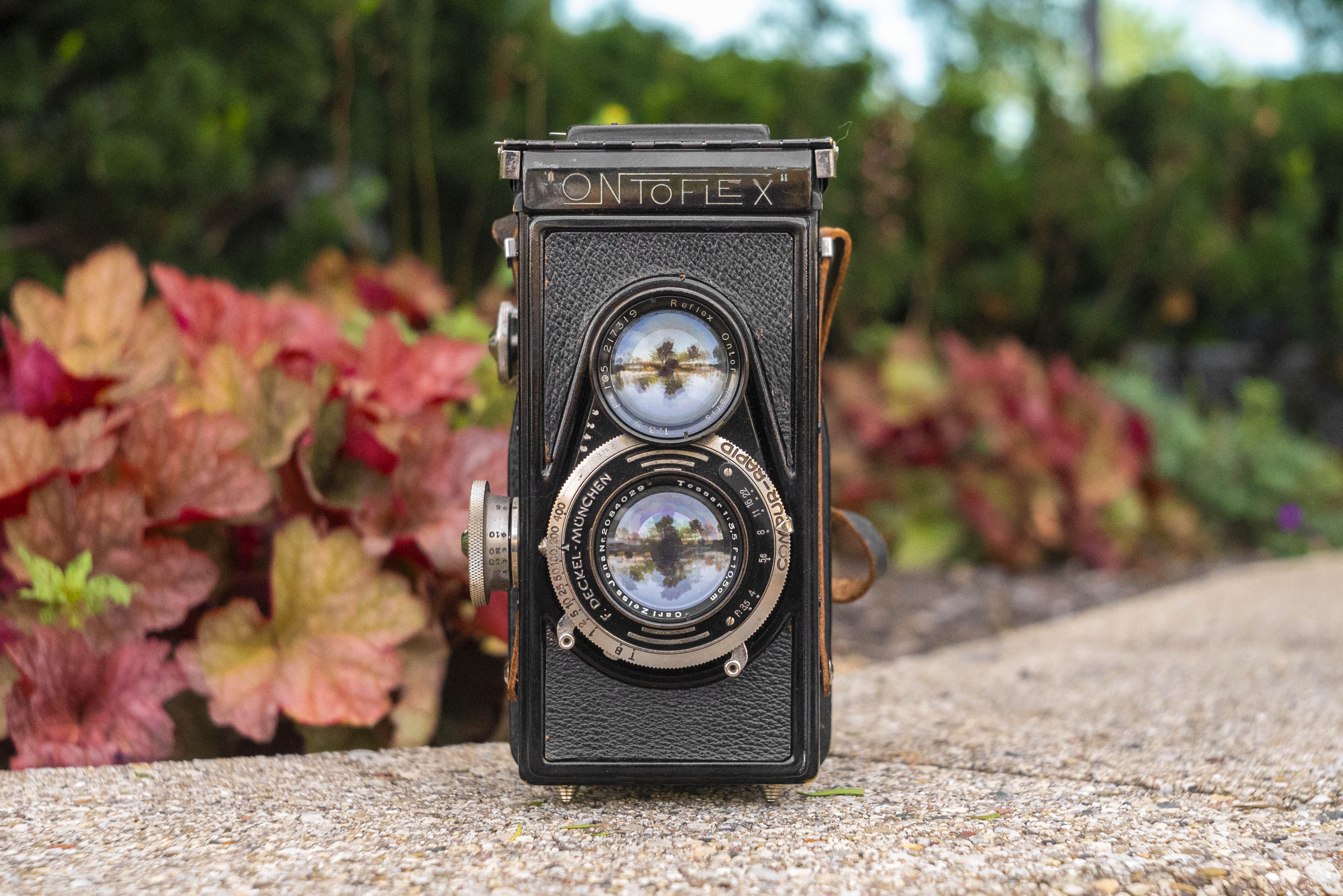
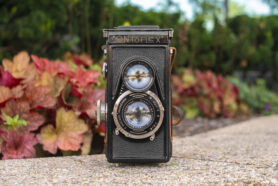
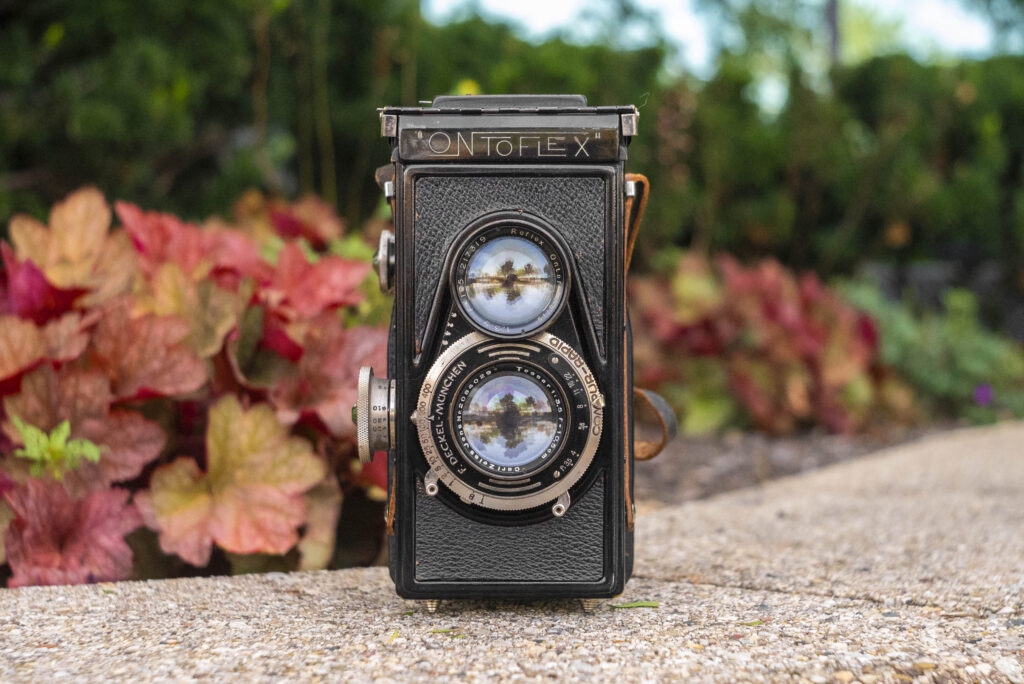







A wonderful article on an often overlooked camera.
Thanks Dan!